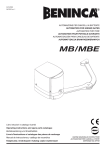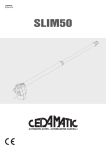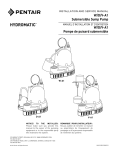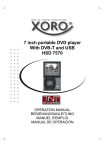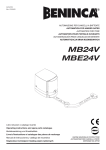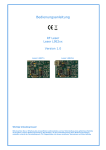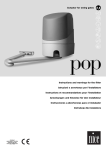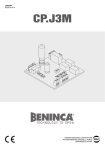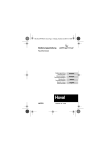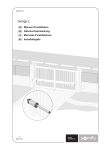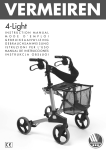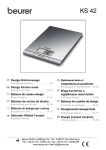Download L8542874 10/2008 rev 0 UNIONE NAZIONALE
Transcript
L8542874 10/2008 rev 0 BEN UNIONE NAZIONALE COSTRUTTORI AUTOMATISMI PER CANCELLI, PORTE SERRANDE ED AFFINI 1 167 35 140 250 230 350 75 350 2 E B C A D α° α° 3 120 60 40 MIN.140 mm 2 60 B A A (mm) B (mm) C (mm) D (mm) E (mm) 90° 90° 90° 90° 90° 0 50 100 150 185 470 470 470 470 470 382 373 370 375 412 253 261 264 260 220 140 140 140 140 160 110° 105° 0 100 420 420 266 305 327 309 200 200 4 5 A P B1 SN T1 T N R D B2 S1 S C V 3 6 7 L C 8 9 D R B1 V 4 10 6 3 4 2 5 H 7 3 11 12 +M2 GND -M2 P P NL 5 14 13 S V2 V2 V 15 V1 P 16 L 6 V Dichiarazione CE di conformità per macchine (Direttiva 89/392 CE, Allegato II, parte B) - Divieto di messa in servizio Fabbricante: Automatismi Benincà SpA. Indirizzo: Via Capitello, 45 - 36066 Sandrigo (VI) - Italia Dichiara che: l’automazione per cancelli a battente modello BEN. • è costruita per essere incorporata in una macchina o per essere assemblata con altri macchinari per costituire una macchina considerata dalla Direttiva 98/37 CE, come modificata; • non è dunque conforme in tutti i punti alle disposizioni di questa Direttiva; • è conforme alle condizioni delle seguenti altre Direttive CE: Direttiva bassa tensione 73/23/CEE, 93/68/CEE. Direttiva compatibilità elettromagnetica 89/336/CEE, 93/68/CEE. e inoltre dichiara che non è consentito mettere in servizio il macchinario fino a che la macchina in cui sarà incorporata o di cui diverrà componente sia stata identificata e ne sia stata dichiarata la conformità alle condizioni della Direttiva 98/37 CE e alla legislazione nazionale che la traspone, vale a dire fino a che il macchinario di cui alla presente dichiarazione non formi un complesso unico con la macchina finale. Benincà Luigi, Responsabile legale. Sandrigo, 08/04/2008. AVVERTENZE E' vietato l'utilizzo del prodotto per scopi o con modalità non previste nel presente manuale. Usi non corretti possono essere causa di danni al prodotto e mettere in pericolo persone e cose. Si declina ogni responsabilità dall'inosservanza della buona tecnica nella costruzione dei cancelli, nonché dalle deformazioni che potrebbero verificarsi durante l'uso. Conservare questo manuale per futuri utilizzi. L'installazione deve essere effettuata da personale qualificato nel pieno rispetto delle normative vigenti. I materiali dell'imballaggio non devono essere lasciati alla portata dei bambini in quanto fonte di potenziale pericolo. Non disperdere nell'ambiente i materiali di imballo, ma separare le varie tipologie (es. cartone, polistirolo) e smaltirle secondo le normative locali. L’installatore deve fornire tutte le informazioni relative al funzionamento automatico, manuale e di emergenza dell'automazione, e consegnare all’utilizzatore dell’impianto le istruzioni d’uso. Prevedere sulla rete di alimentazione un interruttore/sezionatore onnipolare con distanza d’apertura dei contatti uguale o superiore a 3 mm. Verificare che a monte dell’impianto elettrico vi sia un interruttore differenziale e una protezione di sovracorrente adeguati. Alcune tipologie di installazione richiedono il collegamento dell'anta ad un impianto di messa a terra rispondente alle vigenti norme di sicurezza. Durante gli interventi di installazione, manutenzione e riparazione, togliere l’alimentazione prima di accedere alle parti elettriche. Le descrizioni e le illustrazioni presenti in questo manuale non sono impegnative. Lasciando inalterate le caratteristiche essenziali del prodotto il fabbricante si riserva il diritto di apportare qualsiasi modifica di carattere tecnico, costruttivo o commerciale senza impegnarsi ad aggiornare la presente pubblicazione. 7 INTRODUZIONE Ci congratuliamo con Voi per aver scelto il motoriduttore BEN. Tutti gli articoli della vasta gamma Benincà sono il frutto di una ventennale esperienza nel settore degli automatismi e di una continua ricerca di nuovi materiali e di tecnologie all’avanguardia. Proprio per questo, oggi siamo in grado di offrire dei prodotti estremamente affidabili che, grazie alla loro potenza, efficacia e durata, soddisfano pienamente le esigenze dell’utente finale. Tutti i nostri prodotti sono coperti da garanzia. Inoltre, una polizza R. C. prodotti stipulata con primaria compagnia assicurativa copre eventuali danni a cose o persone causati da difetti di fabbricazione. NOTIZIE GENERALI Automazione per la motorizzazione di ante dove gli ingombri fisici, pilastri o colonne di grandi dimensioni pregiudicano l’uso di attuatori tradizionali. BEN è dotato di braccio articolato che consente movimenti regolari e silenziosi, è di facile applicazione e, con il suo gradevole design, è in grado di soddisfare le aspettative più esigenti. È costituito da un gruppo motoriduttore irreversibile realizzato con materiali ad alta resistenza. L’apertura delle ante viene regolata tramite sensore amperometrico. Un fermo meccanico regolabile arresta il movimento in apertura, in chiusura è indispensabile la presenza di un arresto a terra. Lo sblocco di emergenza è a leva con chiave personalizzata e permette la movimentazione manuale del cancello in mancanza di energia elettrica. VERIFICHE PRELIMINARI Per un buon funzionamento dell’automazione, la porta da automatizzare dovrà rispondere alle seguenti caratteristiche: • Buona robustezza e rigidità delle ante. • Cerniere efficienti. • Le ante si muovano manualmente e senza sforzo per tutta la corsa. • Presenza di un fermo d’arresto in chiusura. In caso contrario provvedere alla sostituzione delle parti difettose. L’affidabilità e la sicurezza dell’automazione dipendono dallo stato della struttura del cancello. DATI TECNICI BN.E BN.E Alimentazione di rete -- 230Vac 50Hz Alimentazione motore 24Vdc 24Vdc Potenza assorbita 75 W 75 W 3A 0,6 A 120 Nm 120 Nm Assorbimento Coppia Intermittenza di lavoro uso intensivo IP44 Grado di protezione Temperatura funzionamento 10 s Lubrificazione 8 BN.E: Motoriduttore irreversibile 24Vdc con centrale incorporata. BN: Motoriduttore irreversibile 24Vdc BN.CB: Kit carica batterie installabile a bordo (opzionale) BN. SE: Sblocco a filo per l'apertura di emergenza dall'esterno (opzionale). INSTALLAZIONE FIG.1 DIMENSIONI Misure di ingombro espresse in millimetri. ANCORAGGIO DELLE STAFFE FIG. 2 Rilevare la quota A e, in base all'angolo di apertura desiderato, si ottiene il valore della quota E (asse di fissaggio del motoriduttore) e il valore della quota B (asse fissaggio della staffa sull'anta). Definite queste quote verificare di avere gli spazi di manovra necessari al braccio per completare i movimento di apertura (quote C e D). FIG. 3 Facendo riferimento alla figura, praticare 4 fori di diametro adeguato al tipo di tasselli utilizzati per il fissaggio del motoriduttore al pilastro. I due fori centrali A presenti sulla piastra, non sono normalmente necessari per il fissaggio. Vanno utilizzati solo nel caso il pilastro sia di dimensioni talmente ridotte da non consentire l'uso dei fori esterni. Rispettate la quota minima 140 mm indicata per evitare di installare il motoriduttore troppo vicino al suolo. Se la quota di installazione è comunque inferiore ai 250 mm, per una più agevole installazione, si consiglia di premontare il braccio snodato e il carter di copertura (vedi "ASSEMBLGGIO BRACCI SNODATI"). Praticare 2 fori per il fissaggio della staffa snodo, rispettando il valore della quota B e l'allineamento alla staffa motoriduttore indicato in Fig. 3. Qualora le zone di fissaggio fossero di spessore esiguo o comunque deboli, provvedere a rinforzare tali zone. FIG. 4 Fissare il motoriduttore e la staffa snodo mediante tasselli. La staffa snodo può anche essere saldata al cancello, rispettando in ogni caso le quote di installazione. - - <70 dB Rumorosità CASTROL OPTITEMP LP2 Centrale incorporata NO SI Peso 6 kg 7,9 kg PESO MASSIMO ANTA (kg) 250 200 170 VERSIONI E ACCESSORI - -20°C / +70°C Tempo apertura (90°) LUNGHEZZA ANTA (m) 1 1.5 1.8 - ASSEMBLAGGIO BRACCI SNODATI FIG. 5 - 6 Sbloccare il motoriduttore (vedi paragrafo "Manvora manuale d'emergenza") Inserire il perno P nel foro dell'albero motore A Unire il braccio B1 al braccio B2 e bloccarli con i perno T1 e l'anello di blocco S1 Fissare i bracci all'albero motore A e bloccarli mediante il dado D interponendo la rondella R e l'anello N Agganciare il braccio alla staffa SN e bloccarla con il perno T1 e l'anello di sblocco S1. Applicare il carter di copertura C e fissarlo con le due viti V. In modo similare installare il motoriduttore sull'altra anta (Fig.6), l'unica differenza tra anta destra e sinistra consiste nella posizione del braccio B2. Con il motoriduttore sbloccato aprire completamente le ante e verificate gli spazi di manovra dei due bracci. MANOVRA MANUALE D'EMERGENZA FIG.7 Per movimentare manualmente la porta in caso di mancanza dell’energia elettrica o di avaria: - Aprire lo sportellino scorrevole L - Inserire la chiave personalizzata C, farla ruotare in senso orario di circa 180°. - Il riduttore risulta sbloccato e si può spingere manualmente il cancello. - Per ristabilire il normale funzionamento, ruotare la chiave C in senso antiorario di circa 180°. - Azionare il cancello manualmente fino ad ingranamento avvenuto. POSIZIONAMENTO FERMI MECCANICI DI APERTURA FIG.8 - 9 L'attuatore è dotato di un fermo meccanico regolabile che blocca l'anta raggiunta la posizione di apertura. Con il motoriduttore sbloccato, portare l'anta nella posizione di apertura desiderata (Fig.8). Fissare i fermi meccanici di arresto in battuta con il braccio dritto B1. I fermi meccanici vanno bloccati utilizzando le tre viti V ed i dadi D, interponendo le rondelle R come evidenziato in Fig.9. Le forature presenti sulla piastra consentono incrementi per passi di 10° di apertura. La forma asimmetrica del blocco meccanico consente punti di arresto intermedi, semplicemente rovesciando la posizone di fissaggio. COLLEGAMENTI ELETTRICI FIG.10 La Fig.10 riporta cablaggi da predisporre per una installazione standard. Prima di procedere con il passaggio dei cavi verificate il tipo di cablaggio richiesto per gli accessori effettivamente utilizzati. La quota H rappresenta l'altezza di installazione delle fotocellule, si consiglia una distanza compresa tra i 40 ed i 60 cm. Legenda componenti: 1 Motoriduttore con centrale incorporata BN.E 2 Motoriduttore BN. 3 Fotocellule 4 Selettore a chiave o tastiera digitale 5 Braccio snodato 6 Lampeggiante con antenna incorporata 7 Fermo meccanico in chiusura (obbligatorio) Per il collegamento del motore BN alla centrale, la sezione del cavo deve rispettare i valori indicati di seguito: Lunghezza cavo Dimensioni cavo fino a 5 m 2x2,5mm2 da 5m a 7,5m 2x4mm2 da 7.5 a 10m 2x6mm2 oltre 10m non consigliato Ricordiamo inoltre che è obbligatorio effettuare il collegamento di messa a terra utilizzando l'apposito morsetto. BATTERIE TAMPONE BN.24 FIG.13-14-15 E' disponibile come accessorio opzionale il kit batterie tampone BN.24V che consente il funzionamento dell'automazione anche in caso di interruzione di alimentazione di rete. Per l'installazione delle batterie, procedere come segue: - rimuovere temporaneamente la centrale di comando, fissata al trasformatore dalle 2 viti V evidenziate in Fig.13. - facendo riferimento alla Fig. 14, fissare la piastra di supporto batterie P al motoriduttore con le viti V1, quindi posizionare le due batterie e bloccarle con staffa S e le viti V2. - ripristinare la centrale di comando, in Fig.15 è rappresentato il motoriduttore con installate le batterie. Per il collegamento delle batterie, fate riferimento alle istruzioni fornite con il kit BN.24V. SBLOCCO ESTERNO A FILO BN.SE FIG.16 E' disponibile come accessorio opzionale il dispositivo di sblocco esterno BN.SE, che consente lo sblocco dell'automazione per mezzo di una leva installata in una cassettina antiscasso con chiave personalizzata. E' necessario installare la leva L indicata in Fig.16 e bloccarla con la vite V. Quindi passare il cavo di acciaio C attraverso il foro della leva L e attraverso la piastra di supporto motoriduttore. Quindi infilare il cavo nella guaina e procedere alla registrazione del dispositivo. Per ulteriori informazioni consultate le istruzioni fornite con il dispositivo ATTENZIONE La polizza RC prodotti, che risponde di eventuali danni a cose o persone causati da difetti di fabbricazione, richiede l’utilizzo di accessori originali Benincà. BN.E (Fig.11): Il motore BN.E è dotato di centrale di comando, alla quale va collegato il motoriduttore BN, gli accessori (lampeggiante, fotocelulle, ecc) e i dispositivi di comando (pulsanti, selettori a chiave, ecc). L'alimentazione di rete va portata all'apposito morsetto con portafusibile, come evidenziato in Fig.10. Passare i restanti collegamenti, adeguatamente incanalati, attraverso i passacavi P. Fare riferimento alle istruzioni fornite con la centrale di comando. BN. (Fig.12): Sul motoriduttore BN è presente una morsettiera per il collegamento alla centrale. L'unico collegamento da effettuare è quello del motore (+M2/-M2). 9 EC Declaration of Conformity regarding machines (Directive 89/392 CE, Annex II B) - No servicing Manufacturer: Automatismi Benincà SpA. Address: Via Capitello, 45 - 36066 Sandrigo (VI) - Italia We herewith declare that:the automatic system for swing gates, BEN model. • is intended to be incorporated into a machine or assembled together with other devices to form a machine in compliance with the EC Directive 98/37, as amended; • therefore, is not in every respect complying with this Directive; • is complying with provisions set forth by the following other EC Directive: EC Low voltage Directive (73/23/EEC, 93/68/EEC). EC Directive of Electromagnetic Compatibility (89/336/EEC, 93/68/EEC) Moreover, we herewith declare that the system shall not be put into service until the machine in which the same will be incorporated or of which it will become a component, is acknowledged compliant with the EC Directive 98/73 and applicable national legislation and a related declaration of conformity is drawn up. In other words, no servicing shall be carried out until the system under this declaration does not form one single final machine with other components. Benincà Luigi, Legal responsible. Sandrigo, 08/04/2008. WARNING The product shall not be used for purposes or in ways other than those for which the product is intended for and as described in this manual. Incorrect uses can damage the product and cause injuries and damages. The company shall not be deemed responsible for the non-compliance with a good manufacture technique of gates as well as for any deformation, which might occur during use. Keep this manual for further use. Qualified personnel, in compliance with regulations in force, shall install the system. Packaging must be kept out of reach of children, as it can be hazardous. For disposal, packaging must be divided the various types of waste (e.g. carton board, polystyrene) in compliance with regulations in force. The installer must supply all information on the automatic, manual and emergency operation of the automatic system and supply the end user with instructions for use. 10 An omnipolar switch/section switch with remote contact opening equal to, or higher than 3mm must be provided on the power supply mains.. Make sure that before wiring an adequate differential switch and an overcurrent protection is provided. Pursuant to safety regulations in force, some types of installation require that the gate connection be earthed. During installation, maintenance and repair, cut off power supply before accessing to live parts. Descriptions and figures in this manual are not binding. While leaving the essential characteristics of the product unchanged, the manufacturer reserves the right to modify the same under the technical, design or commercial point of view without necessarily update this manual. INTRODUCTION DOOR LEAF WIDTH (m) LEAF MAXIMUM WEIGHT (kg) 250 200 170 Congratulations on your choice of a BEN gear motor. All items included in Benincà’s wide product range stem from twenty year of our experience in the sector of automatic systems, always striving to find new materials and advanced technologies. For this reason, nowadays we are able to offer you extremely reliable products that, thanks to their power, efficiency and long-lasting features, entirely meet the end user’s requirements. All our products are covered by a guarantee. Furthermore, an R.C. insurance policy signed with a primary insurance company, covers any injuries or damages caused by manufacturing faults. BN.E: Irreversible gear motor, 24Vdc, with built-in control unit. BN: Irreversible gear motor, 24Vdc BN.CB: Battery charger kit, which can be installed on board (optional) BN. SE: Cord release for emergency opening from outside (optional). GENERAL INFORMATION INSTALLATION This system is suited for the automation of gate or door leaves where obstacles, such as large piers or columns, impair the use of traditional actuators. BEN is complete with an articulated arm, which allows a smooth and noiseless movement. It is easy to mount and, thanks to its pleasant design, it is able to fulfil the most demanding requirements. This system is composed of an irreversible gear motor, made with highly rugged materials. The leaf opening is regulated through the amperometric sensor. An adjustable mechanical stop stops the gate leaf movement during closure. It is mandatory to provide for a stop fitted to ground. The emergency release is the lever with customized key which permits the opening or closing of the gate by hand in the event of power failure. PRELIMINARY CHECKS For a good operation of this automatic system, the door to be automated shall fulfil the following characteristics: • Good strength and stiffness of leaves. • Efficient hinges. • The door leaves should be moved by hand and without any effort for their entire stroke. • Presence of a stop in the closing phase. In the negative, replace the defective parts. The reliability and safety of the system depend on the good conditions of the gate structure. SPECIFICATIONS BN.E BN.E Mains power supply -- 230Vac 50Hz Motor power supply 24Vdc 24Vdc Absorbed power 75 W 75 W Absorbed current Torque Jogging 3A 0,6 A 120 Nm 120 Nm Intensive use IP44 Protection level Operation temperature -20°C / +70°C VERSIONS AND ACCESSORIES FIG.1 DIMENSIONS Overall dimensions expressed in millimetres. ANCHORING OF BRACKETS FIG. 2 Measure dimension A and, according to the desired opening angle, the E dimension value (fitting axis of the gear motor) and the B dimension value (fitting axis of the bracket on the door leaf) are obtained. After defining the above measures, check the clearance required to the arms to complete their opening movement (C and D measures). FIG. 3 Referring to the figure, drill 4 holes with a diameter adequate to the type of screw anchors to fix the gear motor to the pier. Usually the two central holes A on the plate are not necessary for fitting. They should be used only in the event the pier is of such reduced dimensions that the external holes are not suited. Keep to the minimum dimension of 140 mm shown to avoid that installation of the gear motor is excessively near groundlevel. If the installation measure is however lower than 250 mm, to facilitate installation it is advisable to pre-assemble the articulated arm and the cover (see “TO ASSEMBLE ARTICULATED ARMS”). Drill 2 holes to fit the articulated joint referring to dimension B and aligning the gear motor to the gear motor bracket, as shown in Fig. 3. If the fitting areas feature a reduced thickness, or are in any case weak, reinforce them. FIG. 4 Fix the gear motor and the articulated joint by means of screw anchors. The articulated joint can be also welded to the gate, referring in any case to the installation measures. 10 s Opening time (90°) <70 dB Noise Lubrication 1 1.5 1.8 CASTROL OPTITEMP LP2 Built-in control unit NO SI Weight 6 kg 7,9 kg - HOW TO ASSEMBLE THE ARTICULATED JOINTS FIG. 5 - 6 Release the gear motor (see paragraph “Emergency manual operation”) Insert pin P in the hole of the motor shaft A Join arm B1 to arm B2 and lock them by means of pin T1 and lock ring S1 Fix the arms to the motor shaft A and lock them by means of nut D by inserting washer R and ring N Hook the arm to bracket SN and lock it by means of pin 11 T1 and release ring S1. - Apply cover C and fix it by means of the two screws V. The gear motor can be installed on the other gate leaf (Fig. 6) in a similar way. The only difference between right-hand and left-hand leaves relies in the position of arm B2. With released gear motor, completely open the gate and check the operating clearances of the two arms. EMERGENCY MANUAL OPERATION FIG.7 To open the gate/door by hand in the event of power failure or breakdown: - Open the sliding door L - Insert the customized key C, turn it clockwise by about 180°. - The reduction gear is released and the gate can be opened or closed by hand. - To reset the normal operation, turn key C anticlockwise by around 180°. - Open or close the gate by hand until the motor is geared. HOW TO POSITION THE OPENING MECHANIC STOPS FIG.8 - 9 The actuator is complete with an adjustable mechanical stop which locks the gate leaf once the opening position has been reached. When the reduction gear is released, open the gate leaf in the desired opening position (Fig.8). Fit the mechanical stops with arm B1 straight, at stokeend. The mechanical stops should be fitted by means of the three screws V and nuts D, by inserting washers R as shown in Fig.9. The holes on the plate allow for increases by steps of 10° opening. The asymmetric shape of the mechanical stop allows for intermediate stops by simply turning the fitting position upside down. WIRE CONNECTIONS FIG.10 Fig.10 shows cables to be provided for a standard installation. Before proceeding with the cable insertion, check the type of cabling required for the accessories actually used. Measure H is the installation height of the photocells. A clearance between 40 and 60 cm is recommended. Key of components: 1 Gear motor with built-in control unit BN.E 2 Gear motor BN. 3 Photocells 4 Key selector or digital keypad 5 Articulated arm 6 Flashing warning light with built-in antenna 7 Mechanical stop in closed position (compulsory) BN.E (Fig.11): the motor BN.E is equipped with control unit, to which the reduction gear BN, accessories (flashing light, photocells, etc.) and control devices (push-buttons, key selectors, etc.) must be connected. The mains power supply is to be connected to the special terminal with fuse holder, as shown in Fig.10. Introduce the remaining cables, suitably positioned into the cable ducts, through cable glands P. Refer to instructions supplied with the control unit. BN. (Fig.12): A terminal board for connection to the control unit (+M2/-M2) is provided on the gear motor BN. 12 For connection of motor BN to the control unit, the cable section should be as follows: Cable length Cable size up to 5 m 2x2,5mm2 from 5m to 7,5m 2x4mm2 from 7.5 to 10m 2x6mm2 Longer than 10m Not recommended Furthermore, it should be noted that ground connection must be made by means of the special terminal. BUFFER BATTERIES BN.24 FIG.13-14-15 The buffer battery kit BN.24V is available as optional accessory. This allows to operate the automatic system also in the event of power failure. To install batteries, proceed as follows: - temporarily remove the control unit, fixed to the transformer by means of the two screws V, shown in Fig.13. - by referring to Fig. 14, fix the battery support plate P to the gear motor by means of screws V1. Then position the two batteries and fix them with bracket S and screws V2. - reset the control unit, in Fig.15 the gear motor is shown with batteries installed. To connect the batteries, refer to instructions supplied with kit BN.24V. EXTERNAL CORD RELEASE BN.SE FIG.16 The external cord release BN.SE is available as optional accessory. This allows to release the automatic system through a lever installed in an anti-shift box with customized key. Lever L should be installed as shown in Fig.16 and locked with screw V. Insert then the steel cable C through the hole of lever L and through the gear motor support plate. Then introduce the cable in the sheath and adjust the device. For further information refer to instructions supplied with the device. WARNING The RC product insurance policy, which covers any injuries or damages to objects caused by manufacturing defects, requires the use of Benincà’s original accessories. EG-Konformitätserklärung für Maschinen (Richtlinie 89/392 EG, Anhang II, Teil B) – Inbetriebsetzen verboten Hersteller: Automatismi Benincà SpA. Adresse: Via Capitello, 45 - 36066 Sandrigo (VI) - Italia Wir erklären, dass: Die Automatik für Flügeltore Modell BEN • hergestellt worden ist, um in Maschinen eingebaut oder in Verbindung mit anderen Maschinen verwendet zu werden, wodurch die Maschine laut EG-Richtlinie 98/37 als umgeändert gilt; • die Automation entspricht daher nicht allen Punkten der Vorschriften dieser Richtlinie; • sie entspricht folgenden EG-Richtlinien: Niederspannungs-Richtlinie 73/23/EWG, 93/68/EWG. Richtlinie über die elektromagnetische Verträglichkeit 89/336/EWG, 93/68/EWG. Wir erklären zudem, dass die Maschine/Anlage in welche oder in Verbindung mit welcher die Automation installiert wird, nicht in Betrieb gesetzt werden darf, bis sie identifiziert und laut EG-Richtlinie 98/37 sowie laut den nationalen Gesetzen, die zur Umsetzung der EG-Richtlinie erlassen wurden, als konform erklärt worden ist. Die hier genannte Automation muss daher mit der Maschine als ein Ganzes als konform erklärt werden. Benincà Luigi, Rechtsvertreter Sandrigo, 08/04/2008. HINWEISE Das Produkt darf nicht für andere Zwecke oder auf andere Weise verwendet werden, als in der vorliegenden Anleitung beschrieben. Ein ungeeigneter Gebrauch kann das Produkt beschädigen und eine Gefahr für Personen und Sachen darstellen. Wir übernehmen keinerlei Haftung für Schäden, die sich aus einer unsachgerechten Montage der Tore und aus daraus folgenden Verformungen ergeben können. Bewahren Sie dieses Handbuch für Nachschlagzwecke auf. Die Installation darf nur von qualifizierten Fachleuten laut den geltenden Vorschriften vorgenommen werden. Das Verpackungsmaterial fern von Kindern halten, da es eine potentielle Gefahr darstellt. Das Verpackungsmaterial nicht ins Freie werfen, sondern je nach Sorte (z.B. Pappe, Polystyrol) und laut den örtlich geltenden Vorschriften entsorgen. Der Installateur hat dem Benutzer alle Informationen über den automatischen, manuellen Betrieb sowie den NotBetrieb der Automatik zusammen mit der Bedienungsanleitung zu liefern. Das Stromnetz muss mit einem allpoligen Schalter bzw. Trennschalter ausgestattet sein, dessen Kontakte einen Öffnungsabstand gleich oder größer als 3 aufweisen.. Kontrollieren, ob der elektrischen Anlage ein geeigneter Differentialschalter und ein Überspannungsschutzschalter vorgeschaltet sind. Einige Installationstypologien verlangen den Anschluss des Flügels an eine Erdungsanlage laut den geltenden Sicherheitsnormen. Während der Installation, der Wartung und der Reparatur, die Anlage stromlos machen bevor an den elektrischen Teilen gearbeitet wird. Die in diesem Handbuch enthaltenen Beschreibungen und Abbildungen sind nicht verbindlich. Ausgenommen der Haupteigenschaften des Produkts, behält sich der Hersteller das Recht vor eventuelle technische, konstruktive oder kommerzielle Änderungen vorzunehmen ohne dass er vorliegende Veröffentlichung auf den letzten Stand bringen muss. 13 EINLEITUNG Wir gratulieren Ihnen für den Erwerb des Antriebs BEN. Alle Artikel der breiten Produktpalette von Benincà sind das Ergebnis einer zwanzigjährigen Erfahrung auf dem Gebiet der Automationen und der ständigen Forschung nach neuen Materialien und den neusten Technologien. Daher sind wir in der Lage äußerst zuverlässige Produkte anzubieten, die durch ihre Leistung, Funktionstüchtigkeit und Lebensdauer allen Erfordernissen des Endkunden nachkommen können. Alle unsere Produkte sind durch eine Garantie gedeckt. Zudem deckt eine Haftpflichtversicherung, die mit einer wichtigen Versicherungsgesellschaft abgeschlossen worden ist, eventuelle Schäden oder Unfälle die sich aus Produktionsmängeln ergeben sollten. TORFLÜGELLÄNGE (m) 1 1.5 1.8 AUSFÜHRUNGEN UND ZUBEHÖR BN.E: Irreversibler Getriebemotor 24Vdc mit eingebauter Zentrale. BN: Irreversibler Getriebemotor 24Vdc BN.CB: Set Batterie-Ladegerät an Bord installierbar (Option) BN. SE: Seilentsicherung für das Öffnen von Außen im Notfall (Option). INSTALLATION ALLGEMEINE INFORMATIONEN Automatik für motorgesteuerte Flügel, bei denen keine herkömmliche Aktuatoren aufgrund der Maße, der zu großen Pfosten oder Säulen eingesetzt werden können. BEN ist mit einem Gelenkarm ausgestattet, der regelmäßige und geräuschlose Bewegungen gewährleistet. Er ist leicht einzusetzen und besitzt ein schönes Design, dass sich auch hohen Anforderungen anpassen lässt. Er besteht aus einem irreversiblen Getriebemotor aus äußerst widerstandsfähigem Material. Die Torflügelöffnung wird über einen Stromsensor geregelt. Ein einstellbarer mechanischer Anschlag für Tor-Auf und Tor-Zu ist vorhanden. Ein Anschlag muss am Boden vorgesehen sein. Eine Notfall-Schlüsselentsicherung mit Hebel gestattet es das Tor bei Stromausfall von Hand zu bedienen. VORBEREITENDE PRÜFUNGEN Für den einwandfreien Betrieb der Automatik, muss das Tor nachstehende Eigenschaften aufweisen: • es muss robust sein und eine gute Festigkeit aufweisen; • es muss mit geeigneten Scharnieren ausgestattet sein; • die Torflügel müssen von Hand widerstandslos bewegt werden können; • ein Anschlag für Tor-Zu muss vorgesehen sein. Anderenfalls, die defekten Teile ersetzen. Die Zuverlässigkeit und Sicherheit der Automatik sind vom Zustand der Torstruktur abhängig. TECHNISCHE DATEN BN.E BN.E Stromversorgung -- 230Vac 50Hz Motorenspeisung 24Vdc 24Vdc Leistungsaufnahme 75 W 75 W Stromaufnahme Drehmoment Intermittierender Betrieb 3A 0,6 A 120 Nm 120 Nm intensiver Gebrauch IP44 Schutzklasse Betriebstemperatur -20°C / +70°C 10 s Öffnungsdauer 90° Schmierung ABB. 1 MASSE Außenmaße in mm. VERANKERUNG DER BÜGEL ABB. 2 Das Maß A messen und je nach dem gewünschten Öffnungswinkel den Wert des Maßes E (Befestigungsachse des Getriebemotors) und den Wert des Maßes B (Befestigungsachse des Bügels am Torflügel) festlegen. Wenn diese Maße festgelegt worden sind, kontrollieren Sie bitte ob genügend Platz für die Armbewegung vorhanden ist, um das Öffnen bis zu Ende zu führen (Maße C und D). ABB. 3 Gemäß der Abbildung, 4 Löcher mit einem für die Befestigungsdübel des Getriebemotors am Pfosten geeigneten Durchmesser bohren. Die beiden zentralen Löcher A an der Platte, sind in der Regel nicht zur Befestigung notwendig. Sie werden lediglich dazu verwendet, wenn der Pfosten so klein ist, dass keine äußeren Löcher verwendet werden können. Halten Sie das Mindestmaß von 140 mm wie angegeben ein, um zu vermeiden, dass der Getriebemotor zu nah am Boden installiert wird. Wenn das Installationsmaß aber weniger als 250 mm beträgt, empfehlen wir den Gelenkarm und den Schutzkasten vorzumontieren, um die Installation zu vereinfachen (siehe „MONTAGE DER GELENKARME“). Zwei Löcher zur Befestigung des Gelenkbügels bohren und den Wert des Maßes B und die Fluchtung mit dem Bügel des Getriebemotors, wie in Abb. 3 gezeigt, beachten. Falls die Befestigungsstellen nicht die geeignete Stärke aufweisen sollten oder zu schwach sind, diese Stellen verstärken. ABB. 4 Den Getriebemotor und den Gelenkbügel mit den Dübeln befestigen. Der Gelenkbügel kann auch an das Tor gelötet werden (die Installationsmaße auf jeden Fall beachten). <70 dB Geräuschpegel CASTROL OPTITEMP LP2 Eingebaute Zentrale NEIN JA Gewicht 6 kg 7,9 kg - 14 MAX. TORFLÜGELGEWICHT (kg) 250 200 170 MONTAGE DER GELENKARME ABB. 5 - 6 Den Getriebemotor entsichern (siehe Paragraph „Manuelle Notbedienung“). Den Stift P in das Loch der Motorenwelle A stecken Den Arm B1 mit dem Arm B2 verbinden und mit dem Stift T1 und dem Sicherungsring S1 blockieren Die Arme an die Motorenwelle A befestigen und mit der Mutter D, der Unterlegscheibe R und dem Ring N blockieren. - Den Arm in den Bügel SN einhaken und mit dem Stift T1 und dem Entsicherungsring S1 blockieren. - Den Schutzkasten C montieren und mit den beiden Schrauben V befestigen. Auf dieselbe Weise den Getriebemotor an den anderen Torflügel (Abb. 6) installieren; der einzige Unterschied zwischen dem rechten und linken Torflügel ist die Position des Arms B2. Bei entsichertem Getriebemotor, die beiden Torflügel vollständig öffnen und die Reichweite der beiden Arme prüfen. MANUELLE NOTBEDIENUNG ABB.7 Bei einem Stromausfall oder im Falle einer Störung, kann das Tor folgendermaßen manuell gesteuert werden: - Die kleine Schiebetür L öffnen - Den kundenspezifischen Schlüssel C einstecken und in den Uhrzeigersinn um ca. 180° drehen. - Nun ist der Reduzierer entsichert und das Tor kann von Hand verschoben werden. - Um den normalen Betrieb wieder herzustellen, Schlüssel C gegen den Uhrzeigersinn um circa 180° drehen. - Das Tor von Hand bewegen, bis es einrastet. MECHANISCHE ANSCHLÄGE FÜR TOR-AUF POSITIONIEREN FIG.8 - 9 Der Aktuator ist mit einem einstellbaren mechanischen Anschlag für Tor-Auf ausgestattet, der den Torflügel in dieser Position blockiert. Bei entsichertem Getriebemotor, den Torflügel in die gewünschte offene Position bringen (Abb. 8). Die mechanischen Anschläge bei ausgestrecktem Arm B1 befestigen. Die mechanischen Anschläge müssen mit drei Schrauben V und den Muttern D, den Unterlegscheiben R, wie in Abb. 9 blockiert werden. Die Löcher an der Platte ermöglichen es die Öffnungsweite schrittweise um jeweils 10° zu erhöhen. Die asymmetrische Form der mechanischen Blockierung bietet noch mehr Einstellungsmöglichkeiten indem die Befestigungsposition einfach umgekehrt wird. ELEKTRISCHE ANSCHLÜSSE ABB.10 Die Abb. 10 zeigt die Verkabelungen wie sie für eine Standardinstallation benötigt werden. Bevor die Kabel durchgeführt werden, kontrollieren ob der Kabeltyp für das verwendete Zubehör geeignet ist. Das Maß H stellt die Installationshöhe der Fotozellen dar. Wir empfehlen einen Abstand zwischen 40 und 60 cm. Erläuterung der Komponenten: 1 Getriebemotor mit eingebauter Zentrale BN.E 2 Getriebemotor BN 3 Fotozellen 4 Schlüsselwähler oder digitale Tastatur 5 Gelenkarm 6 Blinkleuchte mit eingebauter Antenne 7 Mechanischer Anschlag für Tor-Zu (obligatorisch) BN.E (Abb.11): Der Motor BN.E ist mit einer Steuerzentrale ausgestattet an welche der Getriebemotor BN, das Zubehör (Blinkleuchte, Fotozellen usw.) und die Steuerungsvorrichtungen (Tasten, Schlüsselwähler usw.) geschlossen werden müssen. Der Netzstrom muss zur entsprechenden Klemme mit Siche- rung, wie in Abb. 10 gezeigt, geführt werden. Die anderen Anschlusskabel in einer Hülse durch die Kabeldurchgänge P führen. Bitte beziehen Sie sich auf die mit der Steuerzentrale mitgelieferten Anweisungen. BN. (Abb.12): Am Getriebemotor BN ist eine Klemmleiste für die Anschlüsse an die Zentrale vorhanden. Der einzige Anschluss der vorgenommen werden muss, ist der des Motors (+M2/-M2). Für den Anschluss des Motors BN an die Zentrale, muss der Kabelschnitt die nachstehend aufgeführten Werte aufweisen: Kabellänge Kabelgröße bis 5 m 2x2,5mm2 von 5m bis 7,5m 2x4mm2 von 7.5 bis 10m 2x6mm2 mehr als 10 m nicht empfohlen Bitte beachten Sie, dass die Erdung durch die entsprechende Klemme vorgeschrieben ist. PUFFERBATTERIE BN.24 ABB.13-14-15 Als Option ist zudem das Set mit Pufferbatterien BN.24V erhältlich, mit dem der Betrieb der Automatik auch bei Stromausfall gewährleistet werden kann. Die Batterien folgendermaßen installieren: - vorübergehend die Steuerzentrale entfernen, die am Trafo mit 2 Schrauben V befestigt ist (siehe Abb. 13). - Unter Bezugnahme auf Abb. 14, die Halterungsplatte P der Batterien an den Getriebemotor mit den Schrauben V1 befestigen und die beiden Batterien positionieren und mit dem Bügel S und den Schrauben V2 blockieren. - Die Steuerzentrale wieder montieren. Die Abb. 15 zeigt den Getriebemotor mit den installierten Batterien. Für den Anschluss der Batterien beziehen Sie sich bitte auf die entsprechenden Anweisungen, die mit dem Set BN.24V geliefert werden. ÄUSSERE SEIL-ENTSICHERUNG BN.SE ABB.16 Als Option ist zudem das Set der äußeren Entsicherungsvorrichtung BN.SE erhältlich, mit dem die Automatik im Notfall über einen Hebel entsichert werden kann, der in einem sabotagesicheren, mit Schlüssel verschließbaren Kasten installiert ist. Dazu muss der Hebel L wie in Abb. 16 gezeigt installiert und mit der Schraube V befestigt werden. Danach das Stahlseil C durch das Loch des Hebels L und durch die Halterungsplatte des Getriebemotors ziehen. Dann das Kabel in die Hülse stecken und die Vorrichtung regeln. Weitere Informationen sind in den Anweisungen enthalten, die mit der Vorrichtung geliefert werden. ACHTUNG! Die Haftpflichtversicherung die eventuelle Schäden oder Unfälle die sich aus Produktionsmängeln ergeben sollten, deckt, verlangt den Einsatz von Originalzubehörteilen von Benincà. 15 Déclaration CE de conformité pour machines (Directive 89/392 CE, Annexe II, partie B) – Interdiction de mise en service Fabricant: Automatismi Benincà SpA. Adresse: Via Capitello, 45 - 36066 Sandrigo (VI) - Italia Déclare que: l’automatisme pour portails à battant modèle BEN. • est conçu pour être incorporé dans une machine ou pour être assemblé avec d’autres machines à fin que le tout puisse constituer une machine considérée par la Directive CE, comme modifiée; • donc elle n’est pas conforme point pour point à tous les termes de cette Directive; • elle satisfait les conditions des autres Directives CE ci-dessous: Directive basse tension 73/23/CEE, 93/68/CEE. Directive compatibilité électromagnétique 89/336/CEE, 93/68/CEE. et de plus le fabricant déclare qu’il est formellement interdit de mettre en service l’appareillage jusqu’à ce que la machine dans laquelle il sera incorporé ou dont il deviendra une partie composante, n’ait été identifiée et déclaré conforme à la Directive 98/37 CE et à sa transposition dans la législation nationale, c’est-à-dire jusqu’à ce que la machine dont à la présente déclaration ne forme pas un complexe unique avec la machine finale. Benincà Luigi, Responsable légal. Sandrigo, 08/04/2008. REGLES DE SECURITE’ Il est interdit d’utiliser ce produit pour l’utilisation du produit ou avec des finalités ou modalités non prévues par le présent manuel. Toute autre utilisation pourrait compromettre l’intégrité du produit et présenter un danger pour les personnes ou pour les biens. Le fabricant décline toute responsabilité en cas d’utilisation impropre ou d’inobservation de la bonne technique dans la construction des portails, ainsi que de toute déformation qui pourrait avoir lieu lors de son utilisation. Toujours conserver la notice pour toute autre consultation future. L’installation doit être faite uniquement par un personnel qualifié dans le respect total des normes en vigueur. Tenir à l’écart des enfants tous les matériaux d’emballage car ils représentent une source potentielle de danger. Ne pas disperser les matériaux d’emballage dans l’environnement, mais trier selon les différentes typologies (i.e. carton, polystyrène) et les traiter selon les normes locales. L’installateur doit fournir toutes les informations relatives au fonctionnement automatique, au déverrouillage d’urgence de l’automatisme, et livrer à l’utilisateur les modes d’emploi. 16 Prévoir sur le réseau de l’alimentation un interrupteur / sectionneur omnipolaire avec distance d’ouverture des contacts égale ou supérieure à 3 mm.. Vérifier la présence en amont de l’installation électrique d’un interrupteur différentiel et d’une protection de surcourant adéquats. Certains types d’installation requièrent le branchement du vantail à une installation de mise à terre satisfaisant les normes de sécurité e vigueur. Avant toute intervention, d’installation, réparation et maintien, couper l’alimentation avant d’accéder aux parties électriques. Les descriptions et les illustrations présentées dans ce manuel ne sont pas contraignantes. En laissant inaltérées les caractéristiques essentielles du produit, le fabricant se réserve le droit d’apporter toute modification à caractère technique, de construction ou commerciale sans s’engager à revoir la cette publication. INTRODUCTION Compliments pour avoir choisi le motoréducteur BEN. Tous les articles de la vaste gamme de produits Benincà sont le fruit d’une expérience vicennale dans le secteur des automatismes et d’une recherche sans cesse de nouveaux matériaux et technologies de pointe. Voilà pourquoi aujourd’hui nous sommes à même d’offrir des produits d’extrême fiabilité qui, grâce à leur puissance, efficacité et duré, répondent tout à fiat aux exigences de l’utilisateur final. Tous nos produits sont couverts par la garantie. De plus, une police R. C. sur le produits stipulée avec une compagnie d’assurance de primaire importance, couvre d’éventuels dommages à personnes ou biens causés par des défauts de fabrication. INFORMATIONS GENERALES Automatisme pour la motorisation des vantaux où tout encombrement physique, poteau ou colonne de grandes dimensions compromettent l’utilisation des actuateurs traditionnels. BEN est équipé d’un bras articulé qui permet des mouvements réguliers et silencieux. Facile à appliquer et, grâce à son dessin agréable, il est capable de satisfaire les attentes les plus exigeantes. Il est constitué d’un groupe motoréducteur irréversible réalisé avec des matériaux à haute résistance. L’ouverture des vantaux est réglée à l’aide d’un senseur ampérométrique. Une butée mécanique réglable arrête le mouvement en ouverture, en fermeture il faut la présence d’une buté d’arrêt au sol. Le déverrouillage d’urgence est le levier avec clé personnalisée et il permet le déplacement manuel du portail en cas de panne de courent. CONTRÔLES PRELIMINAIRES Pour un bon fonctionnement des automatismes en objet, le portail à automatiser devra posséder les caractéristiques suivantes: • bonne robustesse et rigidité des vantaux. • Charnières en bon état. • Les vantaux doivent s’ouvrir manuellement et sans effort pendant toute la course. • Présence d’une buté d’arrêt en fermeture. Au cas contraire il faudra substituer les pièces défectueuses. La fiabilité et la sécurité de l’automatisme dépendent de l’état de la structure du portail. DONNEES TECHNIQUES BN.E BN.E Alimentation secteur -- 230Vac 50Hz Alimentation moteur 24Vdc 24Vdc Puissance absorbée 75 W 75 W Absorption Couple Intermittence de travail 3A 0,6 A 120 Nm 120 Nm 10 s Temps d’ouverture (90°) <70 dB Bruyance Lubrification BN.E: Motoréducteur irréversible 24Vdc avec centrale intégrée. BN: Motoréducteur irréversible 24Vdc BN.CB: Kit chargeur de batteries installable à bord (en option) BN.SE: Déverrouillage par câble pour l’ouverture d’urgence de l’extérieur (en option). INSTALLATION FIG.1 DIMENSIONS Mesures d’encombrement exprimées en millimètres. ANCRAGE DES BRIDES FIG. 2 Après avoir relevé la côte A, sur la base de l’angle d’ouverture désiré, vous obtiendrez la valeur de la côte E (axe d’ancrage du motoréducteur) et la valeur de la côte B (axe d’ancrage de la bride sur le vantail). Une fois ces côtes définies vérifiez d’avoir les marges de manœuvre nécessaires pour achever le mouvement d’ouverture (côtes C et D). FIG. 3 En se référant à la figure, pratiquez 4 trous de diamètre adéquat aux chevilles utilisées pour accrocher le motoréducteur au pilier. Les deux trous centraux A présents sur la plaque, généralement ne sont pas nécessaires pour l’ancrage. Ils doivent être utilisés uniquement si les dimensions du pilier sont tellement réduites qu’elles ne permettent pas l’utilisation des trous extérieurs. Respectez la côte minime de 140 mm indiquée afin d’éviter l’installation du motoréducteur trop près au sol. Si toutefois la côte d’installation est inférieure à 250 mm, pour faciliter l’installation, on conseille de monter le bras articulé et le carter de couverture à l’avance (voir «ASSEMBLAGE BRAS ARTICULES»). Percez 2 trous pour l’ancrage de la bride articulée en respectant la valeur de la côte B et l’alignement à la bride motoréducteur indiqué en Fig. 3. Au cas où les zones d’ancrage avaient une épaisseur exiguë ou de toute façon se montraient faibles, on conseille de les renforcer. FIG. 4 Fixez le motoréducteur et la bride articulée à l’aide de chevilles. La bride articulée peut être soudée au portail, en respectant en tout cas les cotes d’installation. IP44 -20°C / +70°C CASTROL OPTITEMP LP2 Centrale intégrée NON OUI Poids 6 kg 7,9 kg POIDS MAXI ANVANNTAIL (kg) 250 200 170 VERSIONS ET ACCESSOIRES Usage intensif Degré de protection Temp.de fonctionnement LONGUEUR VANTAIL (m) 1 1.5 1.8 - ASSEMBLAGE BRAS ARTICULES FIG. 5 - 6 Débloquez le motoréducteur (voir paragraphe «Manœuvre manuelle d’urgence») Insérez le goujon P dans le trou du vilebrequin A Reliez le bras B1 au bras B2 et bloquez-les avec le goujon T1 et la bague de blocage S1 Fixez les bras au vilebrequin A et bloquez-les à l’aide de l’écrou en interposant la rondelle R et la bague N 17 - Accrocher le bras à la bride SN et bloquez-la avec le goujon T1 et la bague de déblocage S1. - Appliquez le carter de couverture C et fixez-le avec les deux vis V. De manière similaire installez le motoréducteur sur l’autre vantail (Fig.6), la seule différence entre les deux vantaux, droit et gauche, est dans la position du bras B2. Avec le motoréducteur débloqué ouvrez complètement les vantaux et vérifiez les marges de manœuvre des deux bras. MANEOEUVRE MANUELLE D’URGENCE FIG.7 Pour actionner manuellement le portail en cas de coupure de courant ou de panne: - Ouvrez la petite porte coulissante L - Insérez la clé personnalisée C, tournez-la dans le sens des aiguilles d’une montre d’environ 180°. - Le réducteur est débloqué et le portail peut être poussé manuellement. - Pour rétablir le fonctionnement normal, tourne la clé C dans le sens inverse des aiguilles d’une montre d’environ 180°. - Actionnez le portail manuellement jusqu’à obtenir l’engrènement. POSITIONEMENT DES BUTEES MECANIQUES D’OUVERTURE FIG.8 - 9 L’Actuateur est équipé d’une butée mécanique réglable qui bloque le vantail une fois la position d’ouverture atteinte. Avec le motoréducteur débloqué, portez le vantail dans la position d’ouverture désirée (Fig.8). Fixez les butées mécaniques d’arrêt en butée avec le bras droit B1. Les butées mécaniques doivent être bloquées à l’aide des trois vis V et des écrous D, en interposant les rondelles R, comme mis en évidence dans la Fig.9. Les perçages présents sur la plaque permettent des incréments pour pas de 10° d’ouverture. La forme asymétrique de la butée mécanique permet des points d’arrêt intermédiaires, tout simplement en renversant la position de fixation. BRANCHEMENTS ELECTRIQUES FIG.10 La Fig.10 illustre les câblages qu’il faut prédisposer pour une installation standard. Avant de procéder avec le passage des câbles vérifiez le type de câblage nécessaire pour les accessoires réellement utilisés. La côte H représente la hauteur d’installation des photocellules, on conseille une distance comprise entre 40 et 60 cm. Légende des composants: 1 Motoréducteur avec centrale intégrée BN.E 2 Motoréducteur BN. 3 Photocellules 4 Sélecteur à clé ou clavier numérique 5 Bras articulé 6 Clignotant avec antenne intégrée 7 Butée mécanique en fermeture (obligatoire) BN.E (Fig.11): Le moteur BN.E est équipé de centrale de commande, à laquelle il faut brancher le motoréducteur BN, les accessoires (clignotant, photocellules, etc.) et les dispositifs de commande (boutons pressoirs, sélecteur à clé, etc.). L’alimentation secteur doit être branchée sur la borne avec porte-fusible prévue à cet effet, comme illustré dans la Fig.10. Faites passer les branchements qui restent, dûment conver18 gés, à travers les passe-fils P. Voir la notice fournie avec la centrale de commande. BN. (Fig.12): Le motoréducteur B est équipé d’une plaque à bores pour le branchement avec la centrale. Le seul branchement à effectuer est celui du moteur (+M2/-M2). Pour brancher le moteur BN à la centrale, la section di câble doit respecter les valeurs ci dessous: Longueur du câble Dimensions du câble Jusqu’à 5 m 2x2,5mm2 de 5m à 7,5m 2x4mm2 de 7.5 à 10m 2x6mm2 Plus de 10m non conseillé Il est rappelé en outre qu’il est obligatoire d’effectuer le branchement de mise à terre à l’aide des bornes prévues à cet effet. BATTERIES TAMPONS BN.24 FIG.13-14-15 En option, en tant qu’accessoire, il y a le kit de batteries tampons BN.24V pour permettre le fonctionnement de l’automatisme même e cas de panne électrique. Pour l’installation des batteries procédez comme il suit: - ôtez temporairement la centrale de commande, fixée au transformateur par les 2 vis V, mises en évidence dans la Fig.13. - en se référant à la Fig. 14, fixez la plaque de support des batteries P au motoréducteur à l’aide des vis V1, après quoi positionnez les deux batteries et bloquez-les à l’aide de la bride S et des vis V2. - rétablissez la centrale de commande, dans Fig.15 est illustré le motoréducteur avec les batteries installées. Pour le branchement des batteries, référez-vous à la notice fournie avec le kit BN.24V. DEVEROUILLAGE EXTERIEUR A’ FIL BN.SE FIG.16 En option, en tant qu’accessoire il y a le dispositif de déverrouillage extérieur BN.SE, qui permet de débloquer l’automatisme à l’aide d’un levier installé dans un petit caisson blindé (antieffraction) avec clé personnalisée. Il est nécessaire d’installer le levier L indiqué dans la Fig.16 et de le bloquer à l’aide de la vis V. Par la suite il faut faire passer le câble en acier C à travers le trou du levier L et à travers la plaque de support du motoréducteur. Puis enfilez le câble dans la gaine et procédez à enregistrer le dispositif. Pour tout complément d’information veuillez consulter les instructions fournies avec le dispositif. ATTENTION La police d’assurance RC produits, qui couvre en cas d’éventuels dommages à biens ou personnes provoqués par des défauts de fabrication, requiert l’utilisation d’accessoires originaux Benincà. Declaración CE de conformidad para máquinas (Directiva 89/392 CE, Anexo II, parte B) – Prohibición de puesta en servicio Fabricante: Automatismi Benincà SpA. Dirección: Via Capitello, 45 - 36066 Sandrigo (VI) - Italia Se declara que: la automatización para cancelas de batiente modelo BEN • ha sido construida para ser incorporada en una máquina o para ser ensamblada con otras máquinas para formar una máquina considerada por la Directiva 98/37 CE, como modificada; • no es pues conforme en todos los puntos a las disposiciones de esta Directiva; • cumple las condiciones de las siguientes otras Directivas CE: Directiva baja tensión 73/23/CEE, 93/68/CEE. Directiva compatibilidad electromagnética 89/336/CEE, 93/68/CEE. y declara así mismo que no se permite poner en servicio la maquinaria hasta que la máquina en la cual vaya incorporada o de la cual se vuelve un componente, haya sido identificada y haya sido declarada su conformidad a las condiciones de la Directiva 98/37 CE y a la legislación nacional que la aplica, es decir hasta que la maquinaria objeto de la presente declaración no forme un conjunto único con la máquina final. Benincà Luigi, Responsable legal. Sandrigo, 08/04/2008. ADVERTENCIAS Está prohibido utilizar el producto para finalidades o con modalidades no previstas en el presente manual. Usos incorrectos pueden causar daños al producto y poner en peligro personas y cosas. Se rehúsa cualquier responsabilidad en caso de incumplimiento de la buena técnica en la construcción de las cancelas, así como en cuanto a las deformaciones que pudieran producirse durante el uso. Guardar este manual para futuras consultas. La instalación debe ser efectuada por personal cualificado respetando plenamente las normas vigentes. Los elementos del embalaje no se deben dejar al alcance de los niños ya que son potenciales fuentes de peligro. No tirar al medio ambiente los elementos del embalaje, sino que se deben separar según los varios tipos (por ej. cartón, poliestireno) y evacuarlos de conformidad con las normas locales. El instalador debe proporcionar todas las informaciones relativas al funcionamiento automático, manual y de emergencia de la automatización y entregar al usuario del equipo las instrucciones de uso. Prever en la red de alimentación un interruptor/ cortacircuitos omnipolar con distancia de apertura de los contactos igual o mayor que 3 mm. Comprobar que entre el aparato y la red eléctrica general haya un interruptor diferencial y una protección contra sobrecorriente adecuados. Algunos tipos de instalación requieren que se conecte la hoja con una instalación de puesta a tierra conforme a las vigentes normas de seguridad. Durante las operaciones de instalación, mantenimiento y reparación, cortar la alimentación antes de acceder a las partes eléctricas. Las descripciones y las ilustraciones presentadas en este manual no son vinculantes. Sin cambiar las características esenciales del producto, el fabricante se reserva el derecho de aportar cualquier modificación de carácter técnico, constructivo o comercial sin obligación de actualizar la presente publicación. 19 INTRODUCCIÓN Le felicitamos por haber elegido el motorreductor BEN. Todos los artículos de la extensa gama Benincà son fruto de veinte años de experiencia en el sector de los automatismos y de una continua investigación de nuevos materiales y de tecnologías punteras. Precisamente por esto hoy conseguimos ofrecer unos productos extremadamente fiables que, gracias a su potencia, eficacia y duración, satisfacen plenamente las exigencias del usuario final. Todos nuestros productos están amparados por garantía. Además, una póliza de Responsabilidad Civil de productos, suscrita con una compañía de seguros de primera plana cubre eventuales daños a cosas o personas debidos a defectos de fabricación. NOTICIAS GENERALES Automatización para la motorización de hojas en el caso de que las dimensiones físicas, pilastras o columnas de grandes medidas impidan utilizar actuadores tradicionales. BEN tiene un brazo articulado que permite movimientos uniformes y silenciosos, es fácil de instalar y, con su diseño agradable, es capaz de satisfacer las expectativas más exigentes. Está formado por un grupo motorreductor no reversible, realizado con materiales de alta resistencia. La apertura de las hojas se ajusta a través de un sensor amperimétrico. Un tope mecánico, regulable detiene el movimiento en apertura, en cierre es indispensable la presencia de un tope en el suelo. El desbloqueo de emergencia es por palanca con llave personalizada y permite desplazar manualmente la cancela si falta la energía eléctrica. COMPROBACIONES PRELIMINARES Para un buen funcionamiento de la automatización, la puerta a automatizar deberá tener las siguientes características: • Buena robustez y rigidez de las hojas. • Bisagras eficientes. • Las hojas deben poder moverse manualmente y sin esfuerzo a lo largo de toda la carrera. • Presencia de un tope de parada en cierre. En caso contrario se debe proceder a sustituir las partes defectuosas. La fiabilidad y la seguridad de la automatización dependen del estado de la estructura de la cancela. BN.E BN.E Alimentación de red DATOS TÉCNICOS -- 230Vac 50Hz Alimentación motor 24Vdc 24Vdc Absorción de potencia 75 W 75 W 3A 0,6 A 120 Nm 120 Nm Consumo Par Clase de servicio IP44 -20°C / +70°C Tiempo de apertura (90°) 10 s INSTALACIÓN FIG.1 MEDIDAS Medidas máximas expresadas en milímetros. ANCLAJE DE LOS ESTRIBOS FIG. 2 Medir la cota A y, sobre la base del ángulo de apertura que se desea, se tiene el valor de la cota E (eje de fijación del motorreductor) y el valore de la cota B (eje de fijación del estribo en la hoja). Determinadas estas cotas hay que comprobar que se tengan los espacios de maniobra que el brazo necesita para completar el movimiento de apertura (cotas C y D). FIG. 3 Con referencia a la figura, taladrar 4 agujeros de diámetro adecuado según el tipo de tacos que se van a utilizar para fijar el motorreductor a la pilastra. Los dos agujeros centrales A presentes en la placa, normalmente no son necesarios para la fijación. Se deben utilizar solamente si la pilastra tiene medidas talmente pequeñas que no permite utilizar los agujeros exteriores. Respetar la cota mínima de 140 mm indicada para evitare instalar el motorreductor demasiado cerca del suelo. Si la cota de instalación de todas maneras es inferior a 250 mm, para una instalación más facilitada se aconseja premontar el brazo articulado y el cobertor (véase “MONTAJE DE BRAZOS ARTICULADOS “). Taladrar 2 agujeros para la fijación del estribo de articulación, respetando el valor de la cota B y la alineación con el estribo de motorreductor indicada en la Fig. 3. Si las zonas de fijación tuvieran un escaso espesor o de todas maneras se presentaran débiles, es necesario proceder a reforzar dichas partes. FIG. 4 Fijar el motorreductor y el estribo de articulación utilizando tacos. El estribo de articulación también se puede soldar a la cancela, respetando siempre las cotas de instalación. - <70 dB Ruido CASTROL OPTITEMP LP2 Central incorporada NO SI Peso 6 kg 7,9 kg 20 BN.E: Motorreductor no reversible 24Vdc con central incorporada. BN: Motorreductor no reversible 24Vdc BN.CB: Kit cargador de baterías instalable a borde (opcional) BN.SE: Desbloqueo por cable para la apertura de emergencia desde el exterior (opcional). - Temp. de funcionamiento PESO MÁXIMO HOJA (kg) 250 200 170 VERSIONES Y ACCESORIOS uso intensivo Grado de protección Lubricación LONGITUD HOJA (m) 1 1.5 1.8 - MONTAJE DE BRAZOS ARTICULADOS FIG. 5 - 6 Desbloquear el motorreductor (véase el apartado “Maniobra manual de emergencia”) Introducir el perno P en el agujero del árbol motor A Unir el brazo B1 al brazo B2 y bloquearlos con el perno T1 y el anillo de bloqueo S1 Fijar los brazos al árbol motor A y bloquearlos con la tuerca D, intercalando la arandela R y el anillo N Enganche el brazo al estribo SN y bloquearlo con el perno T1 y el anillo de desbloqueo S1. - Poner el cobertor C y fijarlo con los dos tornillos V. De manera similar instalar el motorreductor en la otra hoja (Fig.6); la única diferencia entre hoja derecha e izquierda consiste en la posición del brazo B2. Con el motorreductor desbloqueado abrir completamente las hojas y comprobar los espacios de maniobra de los dos brazos. MANIOBRA MANUAL DE EMERGENCIA FIG.7 Para desplazar manualmente la puerta en caso de falta de energía eléctrica o de avería: - Abrir la tapa deslizable L - Introducir la llave personalizada C, darle una vuelta de aproximadamente 180° hacia la derecha. - Se desbloquea el reductor y se puede empujar manualmente la cancela. - Para restablecer el funcionamiento normal, girar la llave C aproximadamente 180° hacia la izquierda. - Accionar la cancela manualmente hasta que se produzca el endentado. COLOCACIÓN DE LOS TOPES MECÁNICOS DE APERTURA FIG.8 - 9 El actuador tiene u tope mecánico regulable que bloquea la hoja una vez alcanzada la posición de apertura. Con el motorreductor desbloqueado, llevar la hoja a la posición de apertura que se desea (Fig.8). Fijar los topes mecánicos de parada en contacto con el brazo recto B1. Los topes mecánicos se deben bloquear utilizando los tres tornillos V y las tuercas D, intercalando las arandelas R como destacado en la Fig.9. Los taladros presentes en la placa permiten incrementos por pasos de 10° de apertura. La forma asimétrica del bloqueo mecánico permite puntos de parada intermedios, simplemente volteando la posición de fijación. CONEXIONES ELÉCTRICAS FIG. 10 La Fig.10 presenta los cableados a preparar para una instalación estándar. Antes de proceder a hacer pasar los cables, comprobar el tipo de cableado necesario para los accesorios efectivamente utilizados. La cota H representa la altura de instalación de las fotocélulas, se aconseja una distancia entre 40 y 60 cm. Explicación de los componentes: 1 Motorreductor con central incorporada BN.E 2 Motorreductor BN. 3 Fotocélulas 4 Selector con llave o teclado digital 5 Brazo articulado 6 Intermitente con antena incorporada 7 Tope mecánico en cierre (obligatorio) aquella del motor (+M2/-M2). Para la conexión del motor BN con la central, se debe seleccionar el cable conforme a los siguientes valores: Longitud del cable Medidas del cable hasta 5 m 2x2,5 mm2 de 5m a 7,5m 2x4 mm2 de 7,5 a 10m 2x6 mm2 más de 10m no aconsejado Destacamos así mismo que es obligatorio efectuar la conexión a tierra utilizando el correspondiente borne previsto. BATERÍAS TAMPÓN BN.24 FIG.13-14-15 Está disponible, como accesorio opcional, el kit de baterías tampón BN.24V que permite el funcionamiento de la automatización también en caso de interrupción de la alimentación de red. Para instalar las baterías, proceder como sigue: - sacar temporalmente la central de mando, fijada al transformador con los 2 tornillos V destacados en la Fig.13. - con referencia a la Fig. 14, fijar la placa de soporte de las baterías P al motorreductor utilizando los tornillos V1, seguidamente situar las dos baterías y bloquearla con el estribo S y los tornillos V2. - poner de nuevo en su sitio la central de mando, en la Fig.15 se muestra el motorreductor con instaladas las baterías. Para la conexión de las baterías, hágase referencia a las instrucciones proporcionadas con el kit BN.24V. DESBLOQUEO EXTERIOR POR CABLE BN.SE FIG.16 Está disponible, como accesorio opcional, el dispositivo externo de desbloqueo BN.SE, que permite desbloquear la automatización a través de una palanca instalada en una caja anti-forzamiento con llave personalizada. Es necesario instalar la palanca L indicada en la Fig.16 y bloquearla con el tornillo V. Seguidamente hacer pasar el cable de acero C a través del agujero de la palanca L y a través de la placa de soporte del motorreductor. Luego introducir el cable en la vaina y proceder a ajustar el dispositivo. Para más información consúltense las instrucciones proporcionadas con el dispositivo. ATENCIÓN La póliza RC de productos, que responde de eventuales daños a cosas o personas causados por defectos de fabricación, impone el uso de accesorios originales Benincà.. BN.E (Fig.11): El motor BN.E tiene central de mando, a la cual se debe conectar el motorreductor BN, los accesorios (intermitente, fotocélulas, etc.) y los dispositivos de mando (pulsadores, selectores de llave, etc.). La alimentación de red se debe llevar al borne correspondiente con portafusible, como destacado en la Fig.10. Hacer pasar las restantes conexiones, en un canal idóneo, a través de los pasadores para cable P. Hágase referencia a las instrucciones proporcionadas con la central de mando. BN. (Fig.12): En el motorreductor BN hay una regleta para la conexión con la central. La única conexión a efectuar es 21 Deklaracja zgodności z normą CE dotyczącą maszyn (Dyrektywa 89/392 CE, Załącznik II, część B) – Zakaz rozpoczęcia użytkowania Producent: Automatismi Benincà SpA. Adres: Via Capitello, 45 - 36066 Sandrigo (VI) - Italia Oświadcza, że: napęd automatyczny do bram skrzydłowych model BEN • zostało wyprodukowane celem przyłączenia go do maszyny lub zmontowania z innymi urządzeniami w celu stworzenia maszyny pojmowanej tak, jak podaje Dyrektywa 98/37 CE, zaktualizowana; • tak więc nie jest zgodne we wszystkich punktach z wymogami tej Dyrektywy; • zgodne jest z wymogami innych, niżej podanych Dyrektyw CE: Dyrektywa o niskim napięciu 73/23/CEE, 93/68/CEE Dyrektywy o zgodności elektromagnetycznej 89/336/CEE, 93/68/CEE i ponadto oświadcza, że zabrania się rozpoczęcia użytkowania wyposażenia maszynowego do chwili, kiedy maszyna, do której jest ono włączone, lub którego będzie komponentem, zostanie zidentyfikowana i będzie posiadać oświadczenie zgodności z wymogami Dyrektywy 98/37 CE i krajowych przepisów prawnych ujednoliconych ze wspomnianą Dyrektywą, to znaczy, do momentu, kiedy wyposażenie maszynowe, którego dotyczy niniejsza deklaracja stanie się częścią składową maszyny w jej postaci końcowej. Benincà Luigi, Odpowiedzialny za kwestie prawne. Sandrigo, 08/04/2008. OSTRZEŻENIA Zabrania się używania produktu do celów i w sposób inny niż przewidziane w niniejszym podręczniku. Nieprawidłowe używanie może spowodować uszkodzenie produktu i stanowić zagrożenie dla osób i rzeczy. Nie bierze się na siebie żadnej odpowiedzialności za nieprzestrzeganie reguł dobrej techniki budowlanej przy realizacji bram, a także w przypadku odkształceń, które mogłyby powstać w trakcie użytkowania. Przechowywać niniejszy podręcznik do przyszłego użytku. Instalacja musi być wykonana przez wykwalifikowany personel z zachowaniem wszelkich obowiązujących przepisów prawnych. Nie można pozostawiać opakowania w miejscach dostępnych dla dieci, ponieważ może to być niebezpieczne. Nie pozostawiać opakowania w środowisku, tylko podzielić na poszczególne kategorie odpadów (n.p. karton, polistyrol) i zlikwidować je zgodnie z obowiązującymi przepisami miejscowymi. Instalator zobowiązany jest do udzielenia wszelkich informacji dotyczących działania w trybie automatycznym, ręcznym i w przypadku zaistnienia stanu alarmowego automatyzacji i wręczyć użytkownikowi instalacji instrukcję użytkowania. 22 Należy przewidzieć w sieci wyłącznik/odłącznik sekcyjny wielobiegunowy, gdzie odległość rozwarcia między stykami będzie równa lub większa 3 mm.. Sprawdzić, czy przed instalacją elektryczną jest odpowiedni wyłącznik dyferencjalny i zabezpieczenie przed przetężeniem. Niektóre typologie instalacji wymagają podłączenia skrzydła do uziemienia zgodnego z obowiązującymi normami bezpieczeństwa. Podczas prac instalacyjnych, konserwacji i naprawy, przed przystąpieniem do prac na częściach elektrycznych należy odciąć zasilanie. Opisy i ilustracje znajdujące się w niniejszym podręczniku podane są wyłącznie przykładowo. Pozostawiając niezmienione istotne charakterystyki techniczne produktu, producent zastrzega sobie prawo do wprowadzania każdej zmiany o charakterze technicznym, konstrukcyjnym lub handlowym, bez konieczności modyfikowania niniejszej publikacji. WSTĘP DŁUGOŚĆ SKRZYDŁA (m) 1 1.5 1.8 MAKSYMALNY CIĘŻAR SKRZYDŁA (kg) 250 200 170 Gratulujemy Państwu za wybranie siłownika BEN. Wszystkie produkty z szerokiej gamy Benincà są owocem dwudziestoletniego doświadczenia w sektorze automatyzacji oraz ciągłego poszukiwania nowych materiałów i nowoczesnych technologii. Właśnie to sprawia, że jesteśmy w stanie oferować produkty o wyjątkowej niezawodności, które dzięki ich mocy, skuteczności i trwałości mogą w pełni zadowolić wymagania użytkownika. Wszystkie nasze produkty objęte są gwarancją. Ponadto, polisa O. C. produktów, zawarta z uznanym towarzystwem ubezpieczeniowym, pokrywa ewentualne szkody rzeczowe i osobowe spowodowane usterkami fabrycznymi. BN.E: Motoreduktor nieodwracalny 24Vdc z centralką wbudowaną. BN: Motoreduktor nieodwracalny 24Vdc BN.CB: Zestaw ładowarki baterii do zainstalowania w urządzeniu (opcjonalny) BN. SE: Wysprzęglenie awaryjne z linką od zewnątrz (opcjonalne). INFORMACJE OGÓLNE INSTALOWANIE Automatyzacja napędów dla skrzydeł, gdzie wymiary objętościowe, słupy o dużych wymiarach gabarytowych uniemożliwiają zastosowanie tradycyjnych siłowników. BEN wyposażony jest w ramię przegubowe pozwalające na regularne ruchy nie powodujące hałasu, którego zamontowanie nie sprawia trudności, o wzornictwie pozwalającym na zaspokojenie najbardziej wymagających oczekiwań. Składa się z zespołu motoreduktora nieodwracalnego wykonanego z materiałów o wysokiej wytrzymałości. Otwieranie skrzydeł regulowane jest przez czujnik amperometryczny. Mechaniczny regulowany ogranicznik ruchu zatrzymuje ruch na otwarciu, natomiast na zamknięciu konieczna jest obecność ogranicznika na ziemi. Wysprzęglenie awaryjne przy pomocy dźwigni na klucz osobisty pozwala na ręczne przesuwanie bramy w przypadku braku zasilania energią elektryczną. WSTĘPNA KONTROLA WARUNKÓW INSTALACJI Celem prawidłowego działania napędów automatycznych, brama, która zostanie zautomatyzowana powinna: - być solidna i sztywna, - mieć dobrze działające zawiasy, • skrzydła powinny dawać możliwość ręcznego przesuwu na całej długości biegu, bez wysiłku, • powinien być zainstalowany ogranicznik biegu na zamknięciu. W przeciwnym przypadku należy wymienić części wadliwe. Niezawodność i bezpieczne warunki eksploatacji automatyzacji zależą od stanu konstrukcji bramy. DANE TECHNICZNE BN.E BN.E -- 230Vac 50Hz Zasilanie silnika 24Vdc 24Vdc Moc pobierana 75 W 75 W Zasilanie sieciowe Pobór prądu Moment napędowy Częstotliwość pra 3A 0,6 A 120 Nm 120 Nm ZAKOTWICZENIE WSPORNIKÓW RYS. 2 Po ustaleniu wymiaru A, w zależności od żądanego kąta otwarcia otrzymuje się wymiar E (oś zamocowania motoreduktora) oraz wymiar B (oś zamocowania wspornika na skrzydle). Po ustaleniu tych wymiarów sprawdzić obszar manewru wymaganego dla ramienia celem wykonania pełnego ruchu otwarcia (wymiary C i D). RYS. 3 Patrząc na rysunek, wykonać 4 otwory o średnicy odpowiedniej do typu używanych kołków mocujących motoreduktor do słupa. Dwa środkowe otwory A znajdujące się na płycie, zazwyczaj nie są potrzebne do montażu. Używane są tylko w tych przypadkach, kiedy wymiary słupa są tak małe, że nie pozwalają na wykorzystanie otworów zewnętrznych. Konieczne jest przestrzeganie zalecenia minimalnego wymiaru 140 mm, celem uniknięcia zainstalowania motoreduktora zbyt blisko terenu. Jeżeli wymiar instalacyjny jest w każdym razie mniejszy od 250 mm, celem łatwiejszego zainstalowania zaleca się wstępne zamontowanie ramienia przegubowego i obudowy (patrz „MONTOWANIE RAMION PRZEGUBOWYCH”). Wykonać 2 otwory dla zamocowania zacisku przegubu tak, żeby były zgodne z wymiarem B i w linii ze wspornikiem motoreduktora wskazanego na Rys. 3. Gdyby miejsca na zamocowanie miały niewielką grubość i w każdym razie nie były odpowiednio mocne, należy je odpowiednio wzmocnić. RYS. 4 Umocować motoreduktor i zacisk przegubu przy pomocy kołków. Zacisk przegubu może być przyspawany do bramy, w każdym razie zgodnie z wymiarami instalacyjnymi. IP44 - -20°C / +70°C 10 s Czas otwierania na (90°) <70 dB Poziom hałasu Smarowanie RYS.1 WYMIARY Wymiary gabarytowe wyrażone w milimetrach. Używanie intensywne Stopień ochrony Temperatura pracy MODELE I AKCESORIA CASTROL OPTITEMP LP2 Centralka wbudowana NO SI Ciężar 6 kg 7,9 kg - MONTOWANIE RAMION PRZEGUBOWYCH RYS. 5 - 6 Odblokować motoreduktor (patrz paragraf „Ręczny manewr wysprzęglania awaryjnego”) Włożyć kołek P do otworu wału silnika A Złączyć ramię B1 z ramieniem B2 i zablokować je sworzniem T1 oraz pierścieniem mocującym S1 Przymocować ramiona do wału silnika A i zablokowć je przy pomocy nakrętki D wraz z podkładką R i pierścieniem N 23 - Zahaczyć ramię na wsporniku SN i zamocować je przy pomocy sworznia T1 oraz pierścienia odblokowania S1. - Zalożyć obudowę i C i przymocować ją dwiema śrubami V. W podobny sposób należy zainstalowć motoreduktor na drugim skrzydle (Rys. 6), jedyna różnica w montażu na skrzydle prawym lub lewym, to pozycja ramienia B2. Przy motoreduktorze wysprzęglonym otworzyć skrzydła na całą szerokść i sprawdzić obszar manewru obu ramion. RĘCZNE WYSPRZĘGLENIE AWARYJNE RYS.7 W przypadku braku energii elektrycznej lub usterki, celem ręcznego otwarcia skrzydeł bramy należy postępować tak, jak podano poniżej: - Otworzyć przesuwną klapkę L - Włożyć klucz osobisty C, obrócić nim w kierunku zgodnym z ruchem wskazówek zegara o około 180°. - Reduktor będzie wysprzęglony i można popchnąć ręcznie bramę. - W celu przywrócenia normalnego działania obrócić kluczem C w kierunku odwrotnym do ruchu wskazówek zegara o około 180°. - Przesunąć ręcznie bramę aż do zazębienia. UMIESZCZENIE MECHANICZNYCH OGRANICZNIKÓW BIEGU OTWARCIA RYS. 8 - 9 Siłownik wyposażony jest w mechaniczny regulowany ogranicznik biegu, który blokuje skrzydło po osiągnięciu pozycji otwarcia. Przy motoreduktorze odblokowanym przesunąć skrzydło do żądanej pozycji otwarcia (Rys.8). Przymocować mechaniczne ograniczniki biegu tak, żeby stykały się z wyprostowanym ramieniem B1. Mechaniczne ograniczniki biegu należy zamocować przy pomocy trzech śrub V wraz z nakrętkami D oraz podkładkami R, jak wskazano na Rys.9. Otwory znajdujące się na płycie pozwalają na regulacje w wymiarze 10° otwarcia. Asymetryczna forma ogranicznika mechanicznego pozwala na wyznaczenie pośrednich punktów zatrzymania poprzez odwrócenie pozyzji zamocowania. POŁĄCZENIA ELEKTRYCZNE RYS.10 Na Rys.10 przedstawione jest okablowanie, jakie powinno być przygotowane w przypadku typowej instalacji standard. Przed przeciągnięciem przewodów należy sprawdzić jaki typ przewodów wymagany jest do rzeczywiście używanych akcesoriów. Wymiar H oznacza wysokość zamontowania fotokomórek, zaleca się odległość w granicach od 40 do 60 cm. Opis części: 1 Motoreduktor z centralką wbudowaną co BN.E 2 Motoreduktor BN. 3 Fotokomórki 4 Przełącznik kluczowy lub cyfrowa tablica przyciskowa 5 Ramię przegubowe 6 Lampa ostrzegawcza z wbudowaną anteną 7 Mechaniczny ogranicznik biegu na zamknięciu (obowiązkowy) BN.E (Rys.11): Silnik BN.E wyposażony jest w centralkę sterowniczą, do której należy podłączyć motoreduktor BN, akcesoria (lampa ostrzegawcza, fotokomórki i t.d.) oraz urządzenia sterowania (przyciski, przełączniki kluczowe i t.d.). Zasilanie sieciowe należy podłączyć do odpowiedniego zacisku z uchwytem bezpiecznikowym tak, jak wskazane 24 na Rys.10. Przeciągnąć przez odgiętkę P pozostałe połączenia odpowiednio zabezpieczone. Postępować zgodnie z instrukcjami dostarczonymi wraz z centralką sterowniczą. BN. (Rys.12): Na motoreduktorze BN umieszczona jest tablica zaciskowa podłączenia do centralki. Jedyne połączenie jakie należy wykonać odnosi się do silnika (+M2/-M2). Przekrój przewodu połączenia silnika BN z centralką powinien odpowiadać niżej przedstaionym parametrom: Długość przewod Wymiary przewodu do 5 m 2x2,5 mm2 od 5 m do 7,5 m 2x4 mm2 od 7.5 do 10 m 2x6 mm2 ponad 10 m Nie zaleca się Przypominamy ponadto o obowiązku wykonania połączenie uziemienia poługując się odpowiednim zaciskiem. BATERIE AWARYJNE BN.24 RYS.13-14-15 Opcjonalnym elementem do dyspozycji jest zestaw baterii avaryjnych BN.24V, pozwalających na działanie napędu automatyzacji także w przypadku przerwy w zasilaniu sieciowym. W celu zainstalowania baterii należy postępować tak, jak podano poniżej: - odłączyć tymczasowo centralkę sterowniczą przymocowaną do transformatora przez 2 śruby V wskazane na Rys.13. - Patrząc na Rys. 14, przymocować do motoreduktora płytę nośnikową baterii P przy pomocy śrub V1, a następnie umieścić dwie baterie i zablokować je przy pomocy zacisku S i śrub V2. - ponownie przyłączyć centralkę sterowniczą, na Rys.15 przedstawiony jest motoreduktor z zamontowanymi bateriami. Dla połączenia baterii postępować tak, jak wskazano w instrukcjach dostarczonych wraz z zestawem BN.24V. WYSPRZĘGLENIE OD ZEWNĄTRZ NA LINKĘ BN.SE RYS.16 Opcjonalnym elementem do dyspozycji jest urządzenie do wysprzęglania od zewnątrz BN.SE, pozwalające na wysprzęglenie automatyzacji przy pomocy dźwigni znajdującej się w skrzynce przeciwłamaniowej otwieranej kluczem osobistym. Należy zamontować dźwignię L wskazaną na Rys.16 i zamocować ją śrubą V. Następnie przeciągnać stalową linkę C przez otwór znajdujący się w dźwigni L i przez płytę nośnikową motoreduktora. Następnie włożyć linkę do osłony i wyregulować urządzenie. Dodatkowe informacje znajdują się w instrukcjach dostarczonych wraz z urządzeniem. UWAGA Polisa OC produktów, która pokrywa ewentualne szkody rzeczowe i osobowe spowodowane usterkami fabrycznymi, wymaga stosowania oryginalnych akcesoriów Benincà. ISTRUZIONI PER L’UTILIZZATORE BEN NORME DI SICUREZZA • Non sostare nella zona di movimento dell'anta. • Non lasciare che i bambini giochino con i comandi o in prossimità dell'anta. • In caso di anomalie di funzionamento non tentare di riparare il guasto ma avvertire un tecnico specializzato. MANOVRA MANUALE E D’EMERGENZA Per movimentare manualmente la porta in caso di mancanza dell’energia elettrica o di avaria: • Aprire lo sportellino scorrevole L • Inserire la chiave personalizzata C, farla ruotare in senso orario di circa 180°. • Il riduttore risulta sbloccato e si può spingere manualmente il cancello. • Per ristabilire il normale funzionamento, ruotare la chiave C in senso antiorario di circa 180°. • Azionare il cancello manualmente fino ad ingranamento avvenuto. MANUTENZIONE • Controllare periodicamente l’efficienza dello sblocco manuale di emergenza. • Astenersi assolutamente dal tentativo di effettuare riparazioni, potreste incorrere in incidenti; per queste operazioni contattare un tecnico specializzato. • L’attuatore non richiede manutenzioni ordinarie, tuttavia è necessario verificare periodicamente l’efficienza dei dispositivi di sicurezza e le altre parti dell’impianto che potrebbero creare pericoli in seguito ad usura. SMALTIMENTO Qualora il prodotto venga posto fuori servizio, è necessario seguire le disposizioni legislative in vigore al momento per quanto riguarda lo smaltimento differenziato ed il riciclaggio dei vari componenti (metalli, plastiche, cavi elettrici, ecc.); è consigliabile contattare il vostro installatore o una ditta specializzata ed abilitata allo scopo. ATTENZIONE Tutti i prodotti Benincà sono coperti da polizza assicurativa che risponde di eventuali danni a cose o persone causati da difetti di fabbricazione, richiede però la marcatura CE della ”macchina” e l’utilizzo di componenti originali Benincà. 25 BEN USER’S HANDBOOK SAFETY MEASURES • Do not stand within the gate movement area. • Children must not play with controls and near the gate. • In the event of malfunctions, do not attempt to repair the failure but contact the specialised personnel. MANUAL AND EMERGENCY MANOEUVRE To open the gate/door by hand in the event of power failure or breakdown: - Open the sliding door L - Insert the customized key C, turn it clockwise by about 180°. - The reduction gear is released and the gate can be opened or closed by hand. - To reset the normal operation, turn key C anticlockwise by around 180°. - Open or close the gate by hand until the motor is geared. MAINTENANCE • Every month check the good operation of the emergency manual release. • It is mandatory not to carry out extraordinary maintenance or repairs as accidents may be caused.These operations must be carried out by qualified personnel only. • The operator is maintenance free but it is necessary to check periodically if the safety devices and the other components of the automation system work properly. Wear and tear of some components could cause dangers. WASTE DISPOSAL If the product must be dismantled, it must be disposed according to regulations in force regarding the differentiated waste disposal and the recycling of components (metals, plastics, electric cables, etc..). For this operation it is advisable to call your installer or a specialised company. WARNING All Benincá products are covered by insurance policy for any possible damages to objects and persons caused by construction faults under condition that the entire system be marked CE and only Benincá parts be used. 26 HANDBUCH FÜR DEN VERBRAUCHER BEN SICHERHEITSVORSCHRIFTEN • Sich nicht im Bewegungsbereich des Flügels aufhalten. • Nicht zulassen dass Kinder mit den Steuerungen oder in der Nähe des Flügels spielen. • Im Falle von Betriebsstörungen, versuchen Sie nicht die Störung selbst zu beheben, sondern wenden Sie sich an einen qualifizierten Fachmann. MANUELLE BEDIENUNG UND NOTBETRIEB Bei einem Stromausfall oder im Falle einer Störung, kann das Tor folgendermaßen manuell gesteuert werden: - Die kleine Schiebetür L öffnen - Den kundenspezifischen Schlüssel C einstecken und in den Uhrzeigersinn um ca. 180° drehen. - Nun ist der Reduzierer entsichert und das Tor kann von Hand verschoben werden. - Um den normalen Betrieb wieder herzustellen, Schlüssel C gegen den Uhrzeigersinn um circa 180° drehen. - Das Tor von Hand bewegen, bis es einrastet. WARTUNG • Monatliche Kontrolle der manuellen Notentriegelung. • Es ist absolut untersagt, selbstständig Sonderwartung oder Reparaturen vorzunehmen, da Unfälle die Folge sein können; wenden Sie sich an den Techniker. • Der Antrieb braucht keine ordentliche Unterhaltung aber es ist periodisch notwendig die Leistungsfähigkeit der Sicherheitsvorrichtungen und die andere Teile des Anlages zu prüfen. Sie könnten durch Abnutzung Gefaht hervorbringen. ENTSORGUNG Wird das Gerät außer Betrieb gesetzt, müssen die gültigen Gesetzesvorschriften zur differenzierten Entsorgung und Wiederverwendung der Einzelkomponenten, wie Metall, Plastik, Elektrokabel, usw., beachtet werden. Rufen Sie Ihren Installateur oder eine Entsorgungsfirma. ACHTUNG Alle Produkte BENINCA’ wurden mit einem Versicherungsschein versehen, der alle eventuellen Schäden an Dingen oder Personen abdeckt, die durch Herstellungsdefekte hervorgerufen wurden, vorausgesetzt, das Gerät besitzt die Kennzeichnung EU und es wurden original BENINCA’ Einzelkomponenten verwendet. 27 BEN MANUEL D’INSTRUCTIONS POUR L’UTILISATEUR NORMES DE SÉCURITÉ • • • Ne pas stationner dans la zone de mouvement du vantail. Ne pas laisser les enfants jouer avec les commandes ou en proximité du vantail. En cas d’anomalies du fonctionnement ne pas essayer de réparer la panne, mais appelez un technicien compétent. MANŒUVRE MANUELLE ET D’URGENCE Pour actionner manuellement le portail en cas de coupure de courant ou de panne: - Ouvrez la petite porte coulissante L - Insérez la clé personnalisée C, tournez-la dans le sens des aiguilles d’une montre d’environ 180°. - Le réducteur est débloqué et le portail peut être poussé manuellement. - Pour rétablir le fonctionnement normal, tourne la clé C dans le sens inverse des aiguilles d’une montre d’environ 180°. - Actionnez le portail manuellement jusqu’à obtenir l’engrènement. MAINTENANCE • Contrôler tous les mois le bon état du déverrouilleur manuel d’urgence. • S’abstenir impérativement de toute tentative d’effectuer des maintenances extraordinaires ou des réparations, sous risque d’accident. Contactez un technicien spécialisé pour ces opérations. • L’actuateur ne demande pas de manutention ordinaire mais il faut verifier periodiquement l’efficience des dispositifs de sécurité et les autres parties de l’installation qui puissent créer dangers à cause d’usure. DÉMOLITION Au cas où le produit serait mis hors service, il est impératif de se conformer aux lois en vigueur pour ce qui concerne l’élimination différenciée et le recyclage des différents composants (métaux, matières plastiques câbles électriques, etc...) contactez votre installateur ou une firme spécialisée autorisée à cet effet. ATTENTION Tous les produits Benincà sont couverts par une police d’assurance qui répond d’éventuels préjudices corporels ou matériels provoqués à cause de défauts de fabrication, mais qui requiert toutefois le marquage CE de la “machine” et l’utilisation de pièces de rechange d’origine Benincà. 28 MANUAL DE INSTRUCCIONES PARA EL USUARIO BEN NORMAS DE SEGURIDAD • No pararse en la zona de movimiento de la hoja. • No dejar que los niños jueguen con los comandos ni cerca de la cancela. • En caso de anomalía de funcionamiento no intentar reparar el avería sino avisar a un técnico especializado. MANIOBRA MANUAL Y DE EMERGENCIA Para desplazar manualmente la puerta en caso de falta de energía eléctrica o de avería: - Abrir la tapa deslizable L - Introducir la llave personalizada C, darle una vuelta de aproximadamente 180° hacia la derecha. - Se desbloquea el reductor y se puede empujar manualmente la cancela. - Para restablecer el funcionamiento normal, girar la llave C aproximadamente 180° hacia la izquierda. - Accionar la cancela manualmente hasta que se produzca el endentado. MANTENIMIENTO • Controlar periódicamente la eficiencia del desbloqueo manual de emergencia. • Abstenerse absolutamente de intentar efectuar reparaciones, podrían incurrir en accidentes; para estas operaciones contactar con un técnico especializado. • El operador no requiere mantenimiento habitual, no obstante es necesario verificar periódicamente la eficiencia de los dispositivos de seguridad y las otras partes de la instalación que pudiesen crear peligros a causa del desgaste. ELIMINACIÓN DE AGUAS SUCIAS Cada vez que el producto esté fuera de servicio, es necesario seguir las disposiciones legislativas en vigor en ese momento en cuanto concierne a la eliminación de suciedad y al reciclaje de varios componentes (metales, plásticos, cables eléctricos, etc.), es aconsejable contactar con su instalador o con una empresa especializada y habilitada para tal fin. ATENCIÓN Todos los productos Benincà están cubiertos por una póliza de seguros que responde de eventuales daños a personas o cosas, causados por defectos de fabricación, requiere sin embargo la marca CE de la ”máquina” y la utilización de componentes originales Benincà. 29 BEN KSIĄŻECZKA Z INSTRUKCJAMI DLA UŻYTKOWNIKA NORMY BEZPIECZEŃSTWA • Nie przestawać w obszarze przesuwu skrzydła bramy. • Nie pozwolić, żeby dzieci bawiły się sterowaniem bramy lub ogólnie w pobliżu skrzydła. • W przypadku nieprawidłowego działania nie próbować samodzielnie naprawiać uszkodzenie, należy zwrócić się do wyspecjalizowanego technika. STEROWANIE RĘCZNE I AWARYJNE W przypadku braku energii elektrycznej lub usterki, celem ręcznego otwarcia skrzydeł bramy należy postępować tak, jak podano poniżej: - Otworzyć przesuwną klapkę L - Włożyć klucz osobisty C, obrócić nim w kierunku zgodnym z ruchem wskazówek zegara o około 180°. - Reduktor będzie wysprzęglony i można popchnąć ręcznie bramę. - W celu przywrócenia normalnego działania obrócić kluczem C w kierunku odwrotnym do ruchu wskazówek zegara o około 180°. - Przesunąć ręcznie bramę aż do zazębienia. KONSERWACJA • Sprawdzać okresowo sprawność działania ręcznego mechanizmu odblokowującego i bezpieczeństwa. • Nie starać się w żadnym wypadku dokonywać napraw samemu z racji na możliwość ulegnięcia wypadkowi, w celu naprawy należy skontaktować się z technikiem wyspecjalizowanym. • Siłownik nie wymaga normalnej konserwacji, tym niemniej wskazane jest okresowe sprawdzanie sprawności działania elementów bezpieczeństwa i pozostałych części instalacji, mogących stanowić zagrożenie z racji na stan zużycia. ELIMINACJA I DEMOLOWANIE W przypadku gdy urządzenie nie nadaje się już do dalszego użytkowania, w celu pozbycia się go należy ściśle przestrzegać obowiązujących w danym momencie norm prawnych regulujących zróżnicowany rozkład na części i odzyskiwanie niektórych elementów składowych (metale, plastyk, kable elektryczne, itp.); wskazane jest skontaktowanie się z instalatorem lub wyspecjalizowaną firmą, autoryzowaną do tego rodzaju prac. UWAGA Wszystkie produkty Benincà objęte są polisą ubezpieczeniową na pokrycie szkód poniesionych przez rzeczy lub osoby w wyniku wad produkcyjnych, pod warunkiem że urządzenia posiadają oznakowanie CE i oryginalne części Benincà. 30 1 4 2 3 12 7 6 5 8 9 11 10 7 Ref. 1 2 3 4 5 6 7 8 9 10 11 12 Code 9686487 9686484 9686483 9686482 9686491 9686481 9686486 9686480 9686485 9686489 9686490 9686488 Note AUTOMATISMI BENINCÀ SpA - Via Capitello, 45 - 36066 Sandrigo (VI) - Tel. 0444 751030 r.a. - Fax 0444 759728
































